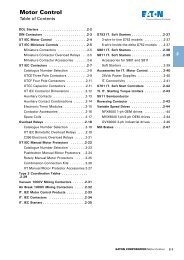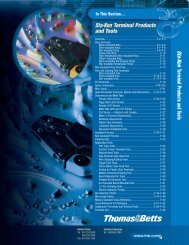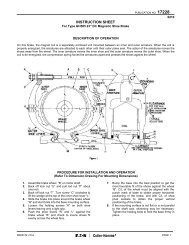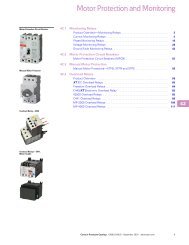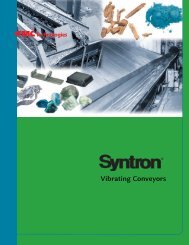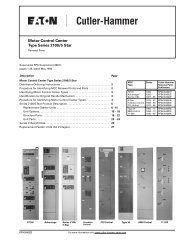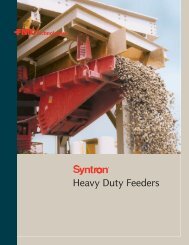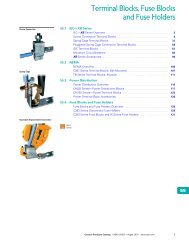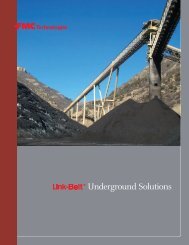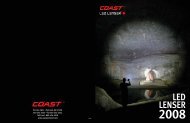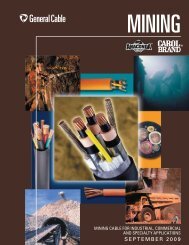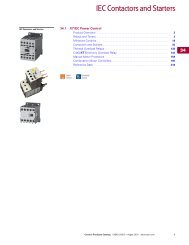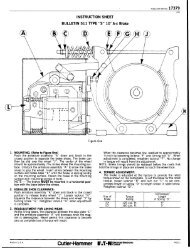NEMA Contactors and Starters - Tri-State Electrical Supply
NEMA Contactors and Starters - Tri-State Electrical Supply
NEMA Contactors and Starters - Tri-State Electrical Supply
You also want an ePaper? Increase the reach of your titles
YUMPU automatically turns print PDFs into web optimized ePapers that Google loves.
33.1<br />
<strong>NEMA</strong> <strong>Contactors</strong> <strong>and</strong> <strong>Starters</strong><br />
Freedom Series<br />
33<br />
33<br />
33<br />
33<br />
33<br />
33<br />
33<br />
33<br />
33<br />
33<br />
33<br />
33<br />
33<br />
33<br />
33<br />
33<br />
33<br />
33<br />
33<br />
33<br />
33<br />
33<br />
33<br />
33<br />
33<br />
33<br />
33<br />
33<br />
33<br />
33<br />
Technical Data <strong>and</strong> Specifications<br />
Operation<br />
C306 Overload Relay Setting<br />
For motors having a 1.15<br />
service factor, rotate the<br />
FLA (Full Load Amperes)<br />
adjustment dial to correspond<br />
to the motor’s FLA rating.<br />
Estimate the dial position<br />
when the motor FLA falls<br />
between two letter values as<br />
shown in the example.<br />
For motors having a 1.0<br />
service factor, rotate the<br />
FLA dial one-half position<br />
counterclockwise (CCW).<br />
FLA Dial Adjustment<br />
1.0<br />
Service<br />
Factor<br />
A<br />
B<br />
1.15<br />
Service<br />
Factor<br />
Example of 12.0 FLA setting<br />
for heater pack number H2011B<br />
showing position for<br />
1.0 or 1.15 service<br />
factor motors.<br />
Class 10 <strong>and</strong> Class 20 <strong>Tri</strong>p Curves<br />
<strong>Tri</strong>p Time<br />
(Seconds)<br />
10,000<br />
5000<br />
4000<br />
3000<br />
2000<br />
1000<br />
500<br />
400<br />
300<br />
200<br />
100<br />
50<br />
40<br />
30<br />
20<br />
10<br />
5<br />
4<br />
3<br />
2<br />
1<br />
0<br />
C<br />
D<br />
The overload relay is factory<br />
set at M for manual reset<br />
operation. For automatic<br />
reset operation, turn the<br />
reset adjustment dial to the<br />
A position as shown in the<br />
illustration.<br />
Automatic reset is not<br />
intended for two-wire<br />
control devices.<br />
Manual/Automatic Reset<br />
M<br />
A<br />
Example of setting for<br />
manual reset.<br />
2 4 6 8 10<br />
Multiples of Current Setting<br />
Class 10 Overload Relay 25°C Open Rating<br />
Test for <strong>Tri</strong>p Indication<br />
To test overload relay for trip<br />
indication when in manual<br />
reset, pull out the blue reset<br />
button. An orange flag will<br />
appear indicating that the<br />
device has tripped. Push<br />
reset button in to reset.<br />
Warning—To provide<br />
continued protection against<br />
fire or shock hazard, the<br />
complete overload relay must<br />
From<br />
Cold Start<br />
From<br />
Hot Start<br />
be replaced if burnout of the<br />
heater element occurs.<br />
General<br />
“Overload relays are provided<br />
to protect motors, motor<br />
control apparatus <strong>and</strong> motorbranch<br />
circuit conductors<br />
against excessive heating<br />
due to motor overloads <strong>and</strong><br />
failure to start. This definition<br />
does not include: 1) motor<br />
circuits over 600V, 2) short<br />
circuits, 3) ground faults<br />
<strong>and</strong> 4) fire pump control.”<br />
(NEC Art. 430-31)<br />
Time Current Characteristics<br />
The time-current<br />
characteristics of an overload<br />
relay is an expression of<br />
performance which defines<br />
its operating time at various<br />
multiples of its current<br />
setting. Tests are run at<br />
Underwriters Laboratories<br />
(UL) in accordance with<br />
<strong>NEMA</strong> St<strong>and</strong>ards <strong>and</strong> the<br />
NEC. UL requires:<br />
● When tested at 100<br />
percent of its current<br />
rating, the overload relay<br />
shall trip ultimately<br />
<strong>Tri</strong>p Time<br />
(Seconds)<br />
10,000<br />
5000<br />
4000<br />
3000<br />
2000<br />
1000<br />
500<br />
400<br />
300<br />
200<br />
100<br />
50<br />
40<br />
30<br />
20<br />
10<br />
5<br />
4<br />
3<br />
2<br />
1<br />
0<br />
2 4 6 8 10<br />
Multiples of Current Setting<br />
Class 20 Overload Relay 25°C Open Rating<br />
●<br />
When tested at 200<br />
percent of its current rating,<br />
the overload relay shall trip<br />
in not more than 8 minutes<br />
●<br />
When tested at 600 percent<br />
of the current rating, the<br />
overload relay shall trip<br />
in not more than 10 or<br />
20 seconds, depending<br />
on the Class of the relay<br />
“Current Rating” is defined<br />
as the minimum current at<br />
which the relay will trip. Per<br />
NEC, an overload must<br />
ultimately trip at 125% of FLA<br />
current (heater) setting for a<br />
1.15 service factor motor <strong>and</strong><br />
115% FLA for a 1.0 service<br />
factor motor.<br />
“Current Setting” is defined<br />
as the FLA of the motor <strong>and</strong><br />
thus the overload heater<br />
pack setting.<br />
Example: 600% of current<br />
rating is defined as 750%<br />
(600 x 1.25) of FLA current<br />
(heater) setting for a 1.15<br />
service factor motor. A 10A<br />
heater setting must trip in 20<br />
seconds or less at 75A motor<br />
current for a Class 20 relay.<br />
From<br />
Cold Start<br />
From<br />
Hot Start<br />
46 Control Products Catalog CA08102001E—August 2010 www.eaton.com



